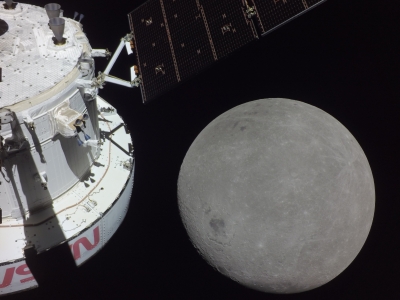Washington: NASA’s Orion spacecraft has successfully performed its first Moon flyby as part of the uncrewed Artemis I mission, to pass within 130 kms of the lunar surface.
According to NASA, on its sixth day into the Artemis I mission, Orion successfully completed its fourth orbital trajectory correction burn using the auxiliary engines ahead the first of two manoeuvres required to enter a distant retrograde orbit around the Moon.
The Orion spacecraft performed the Moon’s closest flyby November 21, the US space agency said in a statement late Tuesday.
“The mission continues to proceed as we had planned, and the ground systems, our operations teams, and the Orion spacecraft continue to exceed expectations, and we continue to learn along the way about this new, deep-space spacecraft,” said Mike Sarafin, Artemis I mission manager.
Orion will enter distant retrograde orbit beyond the Moon on Friday with the second manoeuvre, called the distant retrograde orbit insertion burn.
This orbit provides a highly stable orbit where little fuel is required to stay for an extended trip in deep space to put Orion’s systems to the test in an extreme environment far from Earth.
Orion will travel about 57,287 miles beyond the Moon at its farthest point from the Moon November 25, passing the record set by Apollo 13.
Orion has travelled 216,842 miles from Earth and was 13,444 miles from the Moon, cruising at 3,489 miles per hour.
Artemis I is the first integrated flight test of NASA’s Space Launch System (SLS) rocket, an uncrewed Orion spacecraft.
In 2025, NASA plans to launch the first crewed Moon landings since the Apollo 17 mission in 1972. That will include the first woman and the first person of colour to walk on the Moon.
Artemis I will provide a foundation for human exploration in deep space and demonstrate NASA’s commitment and capability to extend human existence to the Moon and beyond.






































